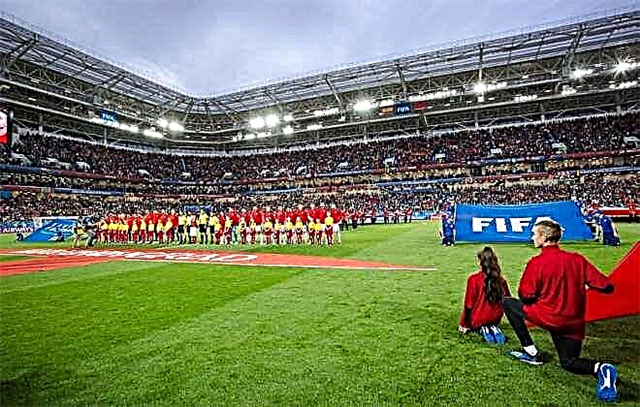The Kingdom of Spain loves sports. Over the years, Spanish athletes have achieved great success in the international arena in many sports disciplines. And yet, speaking about Spanish sports, we first of all think about football. In this country, football is highly respected and considered a national sport - a quarter of a million people visit the games of the best football clubs every week. That is why wonderful spacious sports arenas are being built here. The stadiums of Spain are real architectural monuments, which, while staying in this country, are undoubtedly worth seeing not only for football fans.

Famous Spanish stadiums
Most Spanish stadiums can accommodate at least 40,000 people in their stands, and the largest of them can be attended by about 100,000 spectators. Due to their large capacity, sports arenas, in addition to competitions (football, rugby, athletics), are often used for entertainment events. Let's take a closer look at the most famous stadiums in Spain.
Camp Nou

Traditionally, the list of famous Spanish stadiums is opened by the majestic Camp Nou. Today it is the largest stadium not only in Spain, but throughout Europe.
It is one of the five largest sports grounds in the world, and its capacity is simply amazing - it can accommodate more than 99 thousand visitors.
Many important sporting events have been held here: the European and World Football Championships, the Olympic Football Tournament, as well as the Champions League final.
The largest stadium in Europe is located in Barcelona and is home to the club of the same name. It was built in the middle of the last century and has undergone several renovations since then. Soon, another one is expected to be held, during which it is planned to change the external appearance of the structure, install a retractable roof, as well as increase the number of spectator seats to 106 thousand.
Tours to the stadium are held throughout the year, so everyone can visit it. The most convenient way to get there is by metro. From tourist centers it is better to take the green line L3 to one of the following stations: Palau Reial, Maria Cristina or Zona Universitaria. If you are traveling on the L5 line, you need to get off at the Collblanc or Badal stops.
Find out more about Barcelona's famous stadium in the Camp Nou article.
Santiago Bernabeu

Another major stadium in Spain, the Santiago Bernabeu, is located in Madrid. This is the home ground of Real Madrid Football Club. The football arena got its name in honor of the president of Real Madrid, during whom the club achieved the highest results. Today it is a five-star arena of the UEFA elite category, which seats over 80,000 spectators.
It hosted the Champions League final, several European Cup finals, two UEFA Cup finals, the World Cup final and many other sporting events.
After reconstruction, scheduled for 2021, the updated Bernabeu will receive a sliding roof that will open in 15 minutes, and another grandstand with three thousand seats. At the same time, the roof will be raised to 60 meters, which will make the Real Madrid arena the highest stadium in Europe. The new sports ground is expected to become a true masterpiece of modern architecture.
Excursions are held daily at the Santiago. And even if you are not a football fan, you can still walk around the arena to at least appreciate the scope of architectural thought.
The stadium is located 4.5 km from the center of the Spanish capital, but you can get to it by various means of transport. Buses 14, 27, 40, 43, 120, 126, 147 and 150 go here. You can take the metro (line 10) to the Santiago Bernabeu stop, or the Madrid-Nuevos Ministerios commuter train.
Olympic Stadium

The third largest sports arena in Spain, the Olympic Stadium, is located in Seville. This is a multifunctional sports facility, built in 1999 specifically to host competitions within the framework of the Olympic Games, which, as a result, were never held here. 120 million euros were spent on its construction.
The stadium is equipped with the most modern equipment, all stands, which can accommodate 57 thousand spectators, are covered with a roof, jogging tracks are located around the football field.
During its relatively short history, Olimpiyskiy has already hosted the UEFA Cup final, Davis Cup and King's Cup final matches.
Sometimes the Spanish national football team plays here. The arena is not assigned to any football club, but the teams “Real Betis” and “Sevilla” still sometimes use it for their matches.
In addition, the stadium from time to time hosts various social events, concerts of famous performers.
Mestalla

The Mestalla stadium, built in Valencia back in 1923, accommodates 55 thousand spectators. It is the home arena of the “bats” - this is how the Valencia football players were nicknamed because of the image of this animal on its coat of arms. It was at “Mestalla” that the club became the champion of the country six times, seven times - the owner of the Spanish Cup and twice - the owner of the UEFA Cup.
Throughout its history, the stadium has gone through several renovations. The most ambitious of them was held after the end of the Spanish Civil War, when the stadium was used for other purposes: potatoes were grown here, scrap metal was collected, in addition, the arena served as a transit point for prisoners before they were sent to concentration camps.
The Mestalla acquired its current appearance after the reconstruction, which took place in 2001, as a result of which the number of spectators was increased and huge screens were installed on which fans could watch matches taking place, including in other cities. At one time, the stadium was named after Luis Casanova, the president of the local football club, but in 1994 the old name was returned to it.
Today, excursion tours are organized at Mestala, during which you can visit the athletes' locker rooms, the tunnel through which the players enter the field, the VIP rooms and even the chapel.
The stadium is located in the historic center of the city, so you can walk from the train station or the cathedral. This walk will take approximately twenty minutes. From other parts of the city, you can take metro line 5 to Aragon station.
Vicente Calderon

The Vicente Calderón Stadium is located in the center of Madrid and can accommodate almost 55,000 spectators. It has been awarded the highest 5-star category by UEFA and is the first Spanish stadium to receive this status.
For 51 years (1966 - 2021) “Vicente Calderón” was the home arena of the football club Atletico Madrid, but since last season, Madrid have played at the new stadium “Wanda Metropolitano”.
This arena was built back in the 70s of the last century and at that time was considered one of the most spacious. In addition, its uniqueness was that individual seating was provided for the audience. Due to financial problems, the stands were not built at the same time, and the main one was erected last, therefore it had its own peculiarity - a highway passed right under it.
During its existence, "Vicente Calderon", which got its name in honor of the president of the football club, who did a lot for its development, has been reconstructed more than once. However, in 2007 it was decided to demolish this arena - a park will be laid out in its place and a skyscraper will be built.
You can still get to the stadium by buses No. 17, 18, 23, 34, 35, 36, 50, 56, 116, 118 and 119 or by metro to Pirámides station using line No. 5.
Benito Villamarin

The Benito Villamarine Stadium is located in Seville, Spain and is the home stadium of Real Betis Football Club. In 1982, matches of the World Cup took place here. At that time, the stadium's capacity was about 50 thousand spectators. However, after the renovation carried out in 2016-17, the number of seats was increased to 60,721.
Thus, today Benito Villamarine is the fourth largest stadium in Spain.
The reconstruction of the stadium continues. The club's management is negotiating with HP to turn Benito Villamarine into a smart stadium. Among the improvements - Wi-Fi, which can easily serve up to 60 thousand devices, an application that allows you to order food from a bar in the stadium or improve the seating in the stands.
The new acoustic system will make it possible to hold concerts at the Benito Villamarine and generate additional income, and the field lighting system, consisting of 340 latest generation LEDs, will make it possible to create full-fledged light shows.
Ramon Sanchez Pizjuan

The Ramon Sánchez Pizjuan stadium is also located in Seville. Spanish fans call him “Bombonera”. It is home to Sevilla Football Club and bears the name of its president, who did not live to see its opening.
Ramon Sanchez Pizjuan was opened in 1958. Despite the fact that its arena was built in a classical style for sports facilities, some of its elements are very reminiscent of the architecture of Ancient Rome. Initially, the capacity of the stadium was 80 thousand people, but it was gradually reduced to 45.5 thousand.
Apart from FC Sevilla, the Spanish national team plays here from time to time. It is interesting that for all 22 games that the national team played here, it has never lost.
In 1982, his arena hosted the World Cup matches.
Today, the stadium in Seville is one of the city's most significant landmarks, as well as an iconic place for many football fans. Anyone can visit "Ramon Sanchez Pizjuan" as part of an excursion tour. The stadium is located in the city center, so you can walk here from the train station. If you wish, you can use the buses that travel through the city center or use the metro, having previously studied the map, getting off at the Nervion or Gran Plaza station.
Riasor

The Riazor Stadium is located in the city of La Coruña and can accommodate over 34,000 fans. Today it is the home arena of the football club Deportivo. From time to time, the Spanish national team also plays here.
The stadium was opened back in 1944. At that time, it was the most capacious stadium in Spain - more than 90 thousand people could fit in its arena, taking into account standing places. In subsequent years, the building underwent several reconstructions, as a result of which its capacity was somewhat reduced. In 1982, this stadium hosted the group stage games of the World Cup.
It should be noted that there are a lot of stadiums in Spain. Among the most famous are also the stadium "Balaidos", located in Vigo, "San Mames", which is located in Bilbao, the arena of the football club "Elche" "Estadio Manuel Martinez Valero" and many others.
Stadiums under construction
We have listed far from all the stadiums that function in Spain. Some of them were built a long time ago, but have been under reconstruction for a long time. So, in 2021, the reconstruction of La Paineta Madrid was finally completed, which turned into an ultra-modern stadium with a capacity of 67 703 spectators and was named Wanda Metropolitano thanks to the Chinese company Wanda Group, which is a co-owner and sponsor of Atletico FC Madrid.
The intention to reconstruct their stadium “Camp Nou” was announced by the Catalan “Barcelona”. The project is planned to be implemented in stages in 2017-2021.
Camp Nou will receive a new façade, pedestrian areas with multiple escalators for optimal distribution of spectator streams, as well as an illuminated canopy over all stands. The updated third tier will increase the arena's capacity from the current 99,000 to 105,000 spectators.
By 2021, it is planned to complete the reconstruction and the "Santiago Bernabeu". In addition, new stadiums are being built in Valencia and other cities in the country. So it is quite possible that over time they will become new attractions in Spain.
Conclusions
The football atmosphere is difficult to convey in words, especially if you have the opportunity to plunge into it at one of the stadiums in Spain. This country has a huge number of sports arenas that amaze with their size and are well known all over the world. Moreover, these are not just grounds for holding sports competitions, but real works of architecture that are worth seeing.











